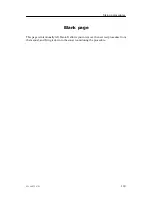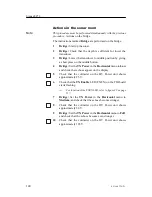
Testing the peripheral equipment
133
851-164336 / D
10.3 Speed log
Introduction
The speed log can come from three different sensor types. Tick off
for the type which will be connected.
•
Pulse log (200 pulses/nm)
•
Speed log (RS-232 serial line)
•
(D)GPS
Refer to the selected speed log source in the following text.
Pulse log (200 pulses per nautical mile)
The pulse log input shall be connected to terminal
TB8
inside the
Sonar Interface Unit.
Observe the following procedure to test the pulse log input:
1
Access the
I/O Setup
menu.
2
Select
Sensors
in the
I/O Setup
menu, then
Speed
and
finally
Speed Log
.
3
Check that the settings in the
Sensor Config
menu
correspond to the sensor settings table. Note that the pulse
log must use serial port no.9.
4
Press
Close
to exit the
Sensor Config
menu.
5
Check that the speed readout in the
Status
menu corresponds
to the vessel’s speed log.
The pulse log connection and interface circuit is located in the
Sonar Interface Unit.
An oscilloscope can be connected to the test point
TP33
to check
if the pulse log signal is present through the comparator IC30
(
TP34
is GND). If not, try to adjust the potentiometer R64. In case
of noise problems, R64 can be adjusted for noise limitation.
Related topics
→
Location of TB8, page 77.
→
Access to the I/O Setup, page 130.
→
Sensor settings table, page 130.
→
Pulse log interface,
page 78.
Speed log with RS-232 serial line
Observe the following procedure to test the speed log input:
Summary of Contents for Simrad SP70
Page 2: ......
Page 14: ...Simrad SP70 X 851 164336 D This page is intentionally left blank...
Page 62: ...Simrad SP70 46 851 164336 D Figure 13 Mounting the Transceiver Unit CD3110A...
Page 226: ...Simrad SP70 210 851 164336 D Party Date Signature Party Date Signature Party Date Signature...
Page 227: ......
Page 229: ......
































